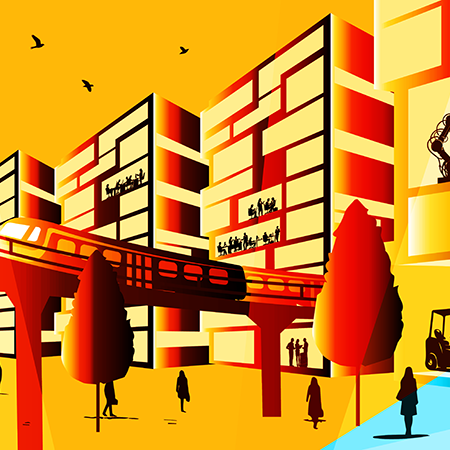What has been the impact of hybrid working on the market?
Hybrid working has had a significant impact on the Sydney office market, although many large tenants have put major leasing decisions on hold as they continue to assess space requirements.
While the full impact is yet to play out, an increasing desire for amenities and talent retention has driven a demand for prime, well-located and newly fitted out spaces.
Office occupancy in the Sydney central business district (CBD) improved markedly over 2023, to about 70%, although it tended to vary significantly over the course of an average week – with much higher occupancy mid-week. While office utilisation is expected to continue to improve, hybrid working appears here to stay, with most employees retaining some degree of flexibility to work remotely.
What are the current office take-up trends?
Demand for office space in the Sydney CBD has declined in recent years. According to the Property Council of Australia, net take-up has declined by about 180,000 square metres (3.4% of total stock) since the advent of the Covid-19 pandemic. The decline reflects some consolidation among occupiers, particularly major banks and tech companies, but also uncertainty over future space requirements due to hybrid working and the slowing economy. This has led many tenants to delay new long-term commitments.
The reduction in net take-up overall masks the stark divergences in demand for space by property grade and precinct. Demand for premium office space has increased by about 80,000 square metres (6.0% of premium-grade office stock) since the beginning of 2020. By contrast, net take-up of secondary space has declined by about 190,000 square metres (9.8% of stock) over the same period.
There is also strong demand for centrally located office space, both in terms of tenants gravitating towards the CBD core from its outer edges, and in terms of moving from suburban markets into the CBD or fringe CBD locations.
How is the upgrade to green standards progressing?
A significant share of Sydney’s office stock needs upgrading. About three-quarters (76%) of Sydney CBD stock by net lettable area (NLA) was built before 2010, according to MSCI Real Capital Analytics. However, of the 298 CBD office buildings built before 2010, only 160 have been subsequently renovated, so there is work to be done.
How are demand and supply dynamics likely to evolve over the next decade?
In Sydney and other Australian state capitals, strong office employment growth, averaging around 2.5% per annum, is expected to underpin a solid demand for office space. Improving office occupancy will also support demand, at least for prime and newly fitted out space.
The Sydney CBD vacancy rate is more than three times higher than pre-pandemic levels, driven predominately by the addition of new supply, but also weaker demand for lower-quality space. The prime office vacancy rate is expected to peak in 2024 at about 14% and then drift lower, but still remain above average levels. Secondary market vacancy is expected to continue to rise over the next few years, reflecting the ongoing weak take-up.
Prime office rental growth is expected to moderate from current levels, but continue to grow solidly over the next few years. Average prime incentives, which have moved sharply higher in recent years, are expected to peak in 2024 and then gradually fall back from elevated levels, driving stronger growth in effective rents. Reflecting well above average vacancy, secondary rents are expected to record much more subdued growth over the next few years.
Savills World Research estimates that between 0.3% and 0.7% of Sydney’s total CBD office stock would need to be repurposed annually over the next ten years to achieve a broadly balanced market. This rate is lower than comparable estimates for some major overseas markets, such as New York and London. This is because of the newer than average office stock in Sydney, as well as relatively strong office employment growth boosting demand for office space.
What are the challenges and opportunities in the repurposing process?
While the impact of hybrid working is still washing through the Sydney office market, demand for office space is increasingly concentrated in prime, well-located and newly fitted out spaces. This highlights the need for refurbishment or repurposing of some lower-grade assets.
The current strong growth in labour and material costs makes the repurposing of office assets challenging in the near-term. However, several planned residential and hotel conversions in the CBD, and the installation of a data centre in an existing office tower (Barrack Place, 151 Clarence Street) highlight the potential to revitalise underutilised space.



